Key points
- Growers from the Harden Murrumburrah Landcare Group and CSIRO scientists celebrate 30 years of partnership in on-farm research at the O’Connor family’s Oxton Park farm
- Overall, minimum tillage and late, cool stubble burning marginally outperformed full stubble retention and direct drilling
- Dual-purpose wheat or canola sown in March or April can increase whole-farm income
- A one-off tillage of direct-drilled soil after 20 years in 2011 had only a temporary impact on soil structure and no negative effects on grain yields over the next five years
- The nutrient needs of soil microbes need to be factored into crop nutrient budgets to avoid nitrogen tie-up, grain yield penalties, and loss of soil organic matter
A two-hectare trial site in southern New South Wales has united growers and researchers in their search for scientific explanations to crop challenges and shaped the thinking behind how many farms in the area are managed today.
Established 30 years ago on the O’Connor family’s Oxton Park farm in the high-rainfall district of Harden, the granite loam site initially hosted a tillage experiment, but interest from growers and scientists alike saw it expand to encompass research on stubble, disease, roots, microorganisms, water, soil carbon and nitrogen.

The gateway to the Harden long-term trial site on the O’Connor family’s Oxton Park farm in southern New South Wales. For 30 years the site hosted CSIRO research with GRDC co-investment to solve problems raised by grower members of the Harden Murrumburrah Landcare Group about zero-tillage cropping and stubble retention. Photo: Nicole Baxter.
Fundamental to the success of the Harden long-term site, as it became known, was the close partnership that developed between CSIRO scientists and grower members of the Harden Murrumburrah Landcare Group. The scientists and growers worked together to ensure the research was relevant and practical.
Cropping practices
Rewind to the late 1980s and CSIRO Agriculture and Food chief research scientist Dr John Kirkegaard says zero-tillage was being embraced by some growers, but not all.
“Farmers in semi-arid areas with sandy soils could direct drill into light stubbles with few problems; however, the heavier stubbles and hard-setting soils of south-eastern NSW provided more obstacles,” Dr Kirkegaard says.
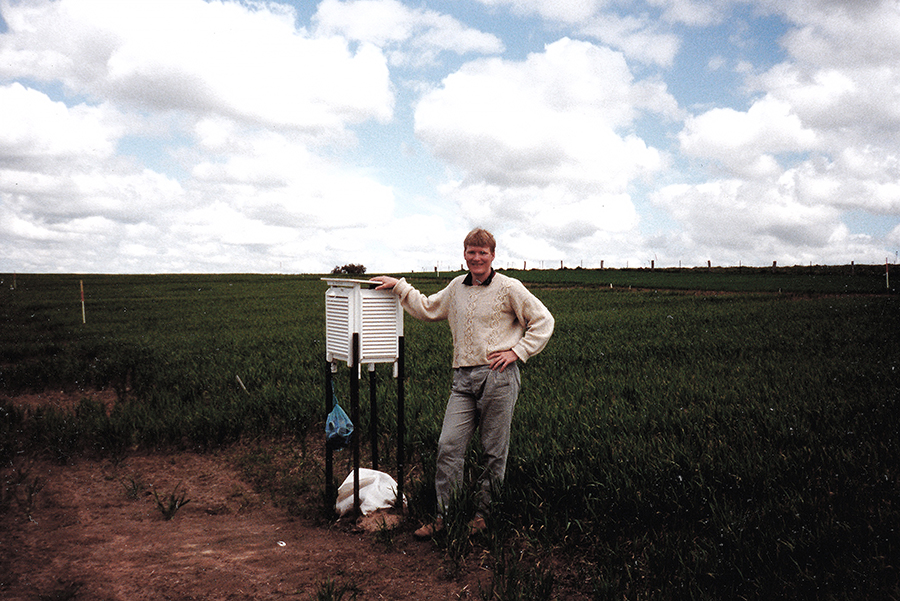
Pictured is Dr John Kirkegaard in 1990 during the first year of the experiment (and his first year working for CSIRO after moving from Queensland) leaning on the weather station at the site. The direct-drilled and stubble-retained wheat crop in 1990 showed slow early growth, which had been observed by the growers. This was what started the search for ways to overcome the limits to crop growth in zero-tillage farming systems. Photo: Dr Julianne Lilley, CSIRO.
In response to this, and the Australian Government’s announcement that 1990 would be the Year of Landcare and the 1990s the Decade of Landcare, CSIRO researchers set to work designing a sustainable farming systems project in south-eastern Australia.
With doctoral experience from the University of Queensland, Dr Kirkegaard, then 26, moved to Canberra to work as a research scientist on the project under the leadership of then CSIRO Plant Industry researcher Dr John Angus.
“At the time, most farmers around Harden reduced their heavy stubble loads with a late-autumn burn and one or two pre-sowing cultivations, but they were keen to give direct drilling a go,” Dr Kirkegaard says.
“Some had tried but were seeing inconsistent yield results, so invited us to set up a trial at Harden to understand what was holding back crop performance under retained stubble and direct drilling.”
Tillage experiment
Accordingly, a five-year experiment was started on the O’Connor family’s Oxton Park farm, with treatments sown into a paddock on the side of a hill that had previously been planted to oats. It was the ideal location to investigate the effects of tillage and stubble management on soil conditions and crop productivity.
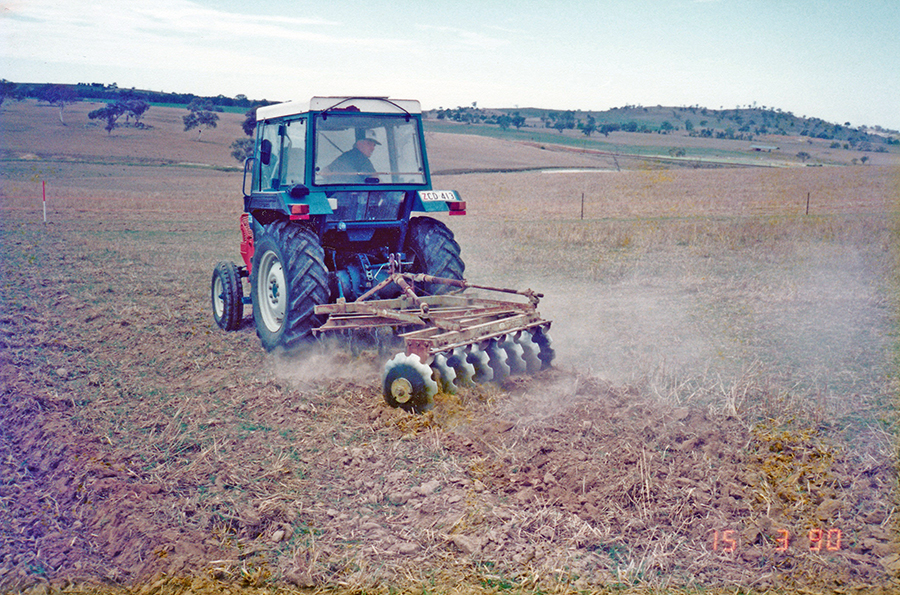
Dr John Kirkegaard’s first day on the job with CSIRO in March 1990 was to apply the ‘stubble-incorporate’ treatments using the traditional method of disc ploughing after rain at the Harden long-term trial site. Leon Smith, who was then a field technician at CSIRO’s Ginninderra Research Station, is driving the tractor. Photo: Dr John Kirkegaard, CSIRO.
Dr Kirkegaard says the intention was to build on earlier research by not repeating previous studies to show the environmental advantages of conservation cropping. As such, none of the treatments examined conventional tillage, which by then had become obsolete.
“We employed a crop sequence of wheat alternating with a break crop, either canola or lupins, over the course of the experiment to minimise the problem of stubble-borne disease,” he says.
“We also aimed for a high standard of crop management with early sowing, a high level of weed control and optimum fertiliser management.”
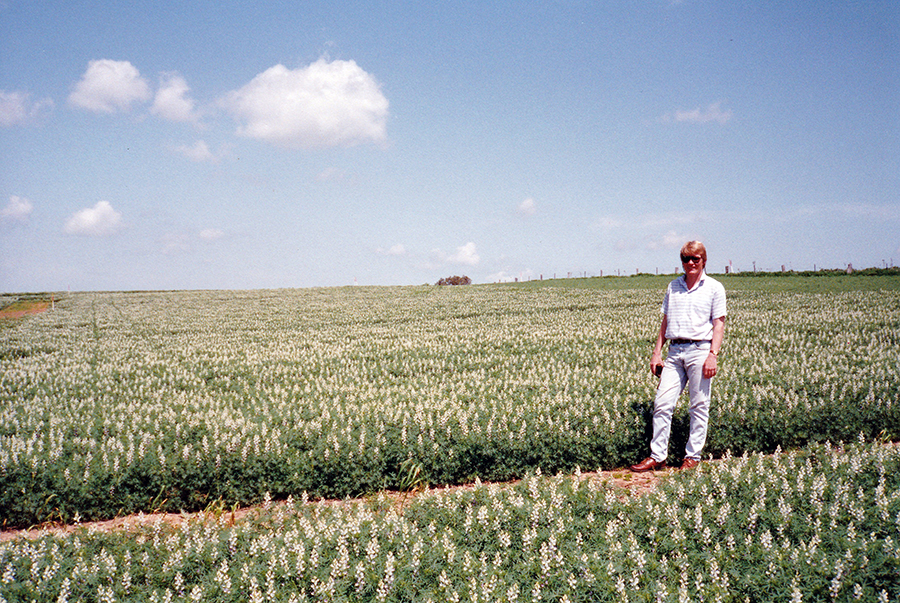
Dr John Kirkegaard pictured at the CSIRO Harden long-term trial site in 1991 with a flowering lupin crop in the background. The experiment maintained a sound crop sequence using wheat in rotation with broadleaf break crops such as lupin and canola to manage weeds and disease. Photo: Dr Julianne Lilley, CSIRO.
The primary treatments compared direct drilling with minimum tillage, and stubble retention with late stubble burning. This stayed the same for 30 years, while other research projects were initiated at the site to answer subsequent questions raised by growers and scientists.
“We wanted to stand with growers and learn with them,” Dr Kirkegaard says. “We worked closely with Harden Murrumburrah Landcare Group’s Louise Hufton and the O’Connor family donated the land for what we thought would be just a five-year project dealing with the agronomic issues of moving to zero tillage.”
Early findings
After five years, the research showed stubble retention and direct drilling consistently reduced early wheat growth compared to wheat grown after late stubble burning and one pre-sowing cultivation.
The mean growth reduction under direct drilling was 20 per cent, despite improvements in soil conditions and microbial biodiversity.
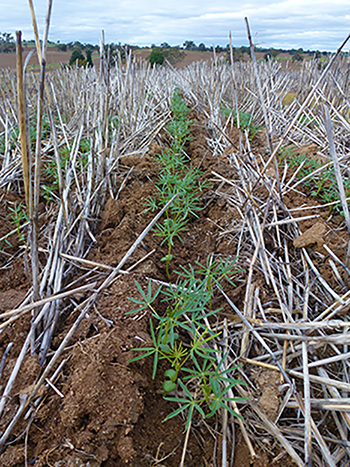
A direct-drilled lupin crop sown between the rows of retained wheat residue at the Harden long-term trial site. It demonstrates the three principles of conservation agriculture, which are to increase crop diversity, reduce tillage and retain crop residue.
Photo: Dr John Kirkegaard, CSIRO.
Accordingly, yields under direct drilling and stubble retention were, on average, 10 per cent lower (except during dry conditions), despite similar plant populations, adequate water and nutrition, and effective establishment. Stubble retention was responsible for three quarters of the yield decrease and direct drilling for one quarter. Interestingly, the impacts did not diminish with time.
Back then, disease, inhibitory microbes, nitrogen leaching and/or nitrogen tie-up were thought to be responsible for the negative effect of direct drilling on growth and yield, but it was not until years later that this ‘hunch’ was properly understood.
“The growers seemed to be getting a lot out of the interaction with us at the Harden trial site, as we were with them, so after the first five years we decided to keep the trial going,” Dr Kirkegaard says.
“Overcoming the constraints to productivity became the focus so grain yield penalties could be avoided in wet years and greater benefits of water conservation could be realised in dry seasons.”
Canola growth
Growers who were direct drilling canola into wheat stubble in the early 1990s commonly observed small canola plants with slow growth that went on to produce lower yields. As a consequence, growers usually burnt their cereal stubble to avoid this costly problem.
Dr Kirkegaard says allelopathy, caused by toxins leaching from the stubble, was thought to be one of the possible reasons for this effect, but he had no conclusive evidence.

CSIRO researchers planted canola during late May at the Harden long-term trial site this year. It was planted late because of the COVID-19 lockdown. The land used for the Harden trial site for the past 30 years will be returned to the O’Connor family after harvest.
Photo: Nicole Baxter.
In a GRDC co-investment involving CSIRO PhD student Sarah Bruce, under the supervision of Dr Kirkegaard, the University of Western Australia’s Dr Megan Ryan and Charles Sturt University’s Dr Jim Pratley, work was carried out to identify the cause of poor canola growth under stubble retention and find ways to fix it.
“Less light under stubble led canola seedlings to allocate more of their biomass to the development of a longer stem to penetrate the stubble at the expense of leaf material,” Dr Kirkegaard says. “Smaller leaves, together with colder minimum temperatures above the stubble layer, were identified as the causes of the reduced canola growth rates.”
The researchers concluded sowing equipment that pushed stubble away from the seeding row might help overcome the problem.
At the time, Dr Kirkegaard says, growers were successfully establishing canola in retained wheat stubble using wider rows, narrow points and press wheels with no trailing harrows.
“Observations on growers’ farms and further experiments at the Harden trial site demonstrated the success of this approach,” he says.
“The growth and yield of canola in treatments where stubble was pushed onto the inter-row were similar to where stubble was removed or burnt.”
At the same time, Dr Kirkegaard says, growers were using GPS technology to sow canola between the rows of standing cereal stubble, eliminating the need for burning.
Wheat growth
With the canola growth problem solved, the next issue to address was why wheat was growing slowly.
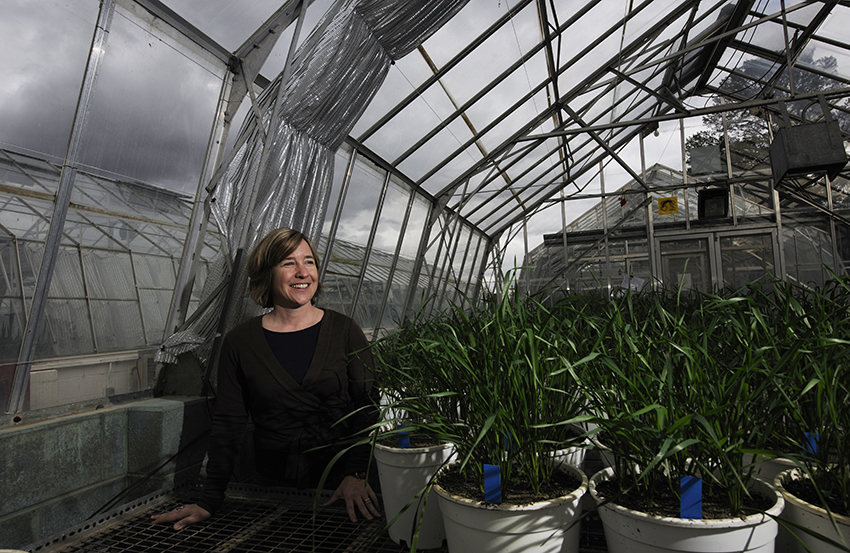
CSIRO’s Dr Michelle Watt discovered inhibitory microbes infected the roots of direct-drilled crops when their growth was impeded in hard direct-drilled soil. Photo: Brad Collis.
One thought was that uncultivated soil was hard, which slowed root growth. The other thought was that Rhizoctonia was suppressing root growth, based on what CSIRO’s Dr Albert Rovira and others had discovered in South Australia.

A young Dr Albert Rovira on sabbatical in the US during the 1960s. Dr Rovira worked at CSIRO in Adelaide on methods to overcome the impact of Rhizoctonia in direct-drilled soils. Photo: CSIRO.
“NSW Department of Primary Industries (DPI) researcher Dr Steven Simpfendorfer suggested inhibitory soil bacteria building up on the roots in zero-tilled soil may be a cause and we followed this up,” Dr Kirkegaard says.
“Detailed studies of the roots and soil microbes led CSIRO’s Dr Michelle Watt to solve the puzzle and provide an explanation and opportunity to increase productivity under direct drilling.”
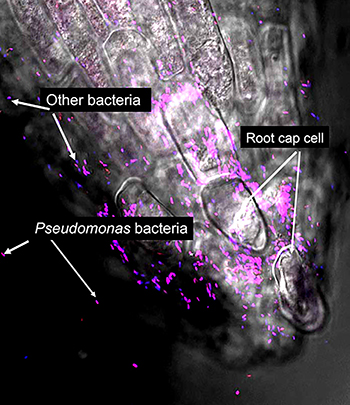 Inhibitory bacteria (fluorescing pink) accumulate on the tips of slow growing wheat roots when they grow in hard, direct-drilled soil. High populations of bacteria release toxins that can slow shoot growth causing poor early vigour. Photo: Dr Michelle Watt, CSIRO.
Inhibitory bacteria (fluorescing pink) accumulate on the tips of slow growing wheat roots when they grow in hard, direct-drilled soil. High populations of bacteria release toxins that can slow shoot growth causing poor early vigour. Photo: Dr Michelle Watt, CSIRO.
What she found, he says, was not just a physical or biological problem, but a combination of the two working together to constrain root growth. Inhibitory microbes infected the root tips of direct-drilled crops when their growth was impeded in hard, direct-drilled soil.
“What growers were doing to overcome this constraint was to sow earlier into warmer soil, which allowed the roots to grow more quickly.
“Growers in SA were also moving away from sweep points to knife points to disturb the soil below the seed and manage Rhizoctonia and, although the disease wasn’t the main problem at Harden, we used these points at the site and they proved successful as a tactic to improve early crop vigour.”
Another remedy tried, in collaboration with Dr Watt and Dr Greg Rebetzke, was to find wheat varieties with more vigorous root systems.
“The extremely vigorous wheat variety H45 was more suited to direct-drilled soils than another popular wheat grown at the time called Janz, which had a low early vigour,” Dr Kirkegaard says.
“However, growers were speeding ahead of us in their uptake of early sowing and knife points to overcome the issue of poor early vigour, which meant the genetic solution was ultimately not pursued.”
High-rainfall challenges
In the 1990s, overcoming the problem of poor early vigour was critical for growers across the Harden district because of the area’s relatively high rainfall, Dr Kirkegaard says.
“Once you set back crops early in the Harden district, in average and better-than-average seasons, they didn’t recover and there would be a 10 to 20 per cent yield penalty,” he says.
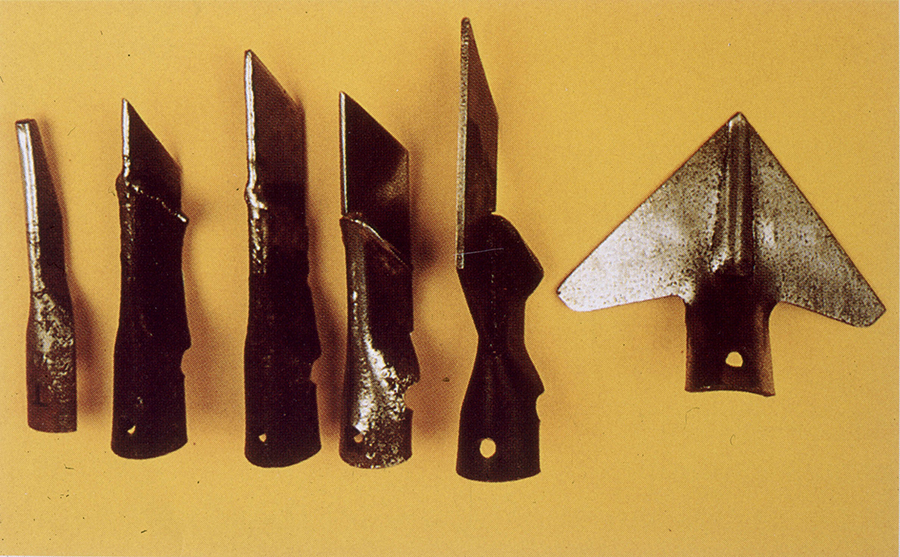
Pictured are the modified narrow seeding points that CSIRO tested to reduce the surface disturbance of soil during sowing while creating a rip line immediately below the seed. CSIRO’s Dr Albert Rovira and his team in Adelaide had tested the points in South Australia and they were also tested at the Harden long-term trial site with success. Originally, the ‘lucerne’ points (left) were used for direct drilling with minimal soil disturbance to replace the full cut-out ‘duck foot’ or ‘sweep’ points (right), however the various types of modified narrow points (centre) proved successful and became used widely. Photo: CSIRO.
“But early sowing allows crops to compensate because the soil is warmer, which leads to more vigorous early growth, and now the whole early sowing revolution has taken off.”
When the Harden trial started in 1990, growers commonly started sowing from late May to early June. Now, growers start a month or more earlier and achieve higher yields by establishing crops and varieties according to their developmental patterns.
Water drainage
When seasonal conditions were comparatively wet in the 1990s, concerns arose about the drainage of water beyond the root zone of annual crops and the impact on dryland salinity.
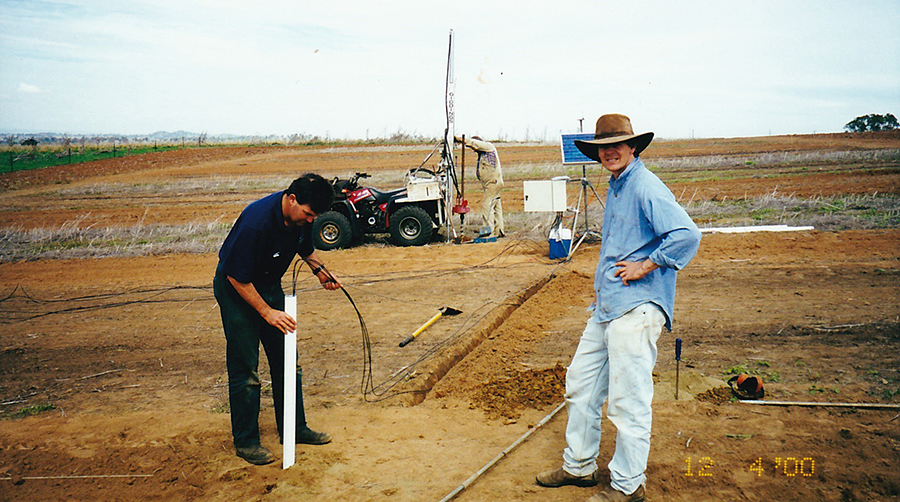
CSIRO's Dr Paul Hutchinson (left with the soil sensor) and Dr Richard Stirzaker (from CSIRO Land and Water) installing the drainage meter at the Harden long-term trial site in 2000. It was the first field testing of the new drainage meters to monitor water movement down the profile. Subsequently a network was installed in the district to monitor soil water movement under different crops and pastures in a project with Harden Murrumburrah Landcare Group. Photo: Dr Julianne Lilley.
Until then, water drainage in crops had proved difficult to measure. But, in 2000, the Harden trial site became the test location of prototype technology developed by then CSIRO engineer Dr Paul Hutchinson. He now owns and runs Griffith-based company Hussat, which makes and installs soil moisture probes.
Dr Hutchinson showed more water was moving beyond the root zone of direct-drilled soil and stubble-retained treatments, which was attributed to improved moisture infiltration.
Inspired by these results, another project was initiated in 2002 with National Heritage Trust and GRDC co-investment to monitor soil water in the root zone and deep drainage in response to different management practices on five farms within a 20-kilometre radius of Harden.
“Growers from the Harden Murrumburrah Landcare Group could look at the water available in the soil under different farming systems and use it to make decisions about late-season urea application,” Dr Kirkegaard says.
Spin-off work
As researchers continued to collect data on crop water use, time of sowing and yields, Dr Kirkegaard says the validation of simulation models was the logical next step. No other trial site, at that time, had generated sufficient data to allow scientists to ask ‘what-if’ questions and confidently predict outcomes.
“CSIRO’s Dr Julianne Lilley took data from the site and validated the Agricultural Production Systems sIMulator (APSIM) model and showed the level of deep drainage was largely associated with above-average rainfall and conditions leading to a full profile in autumn such as high summer rainfall, summer weed control and poor soil water extraction by crops,” he says.
“Although drainage concerns diminished with the onset of the Millennium drought, Dr Lilley suggested longer-season dual-purpose crops would reduce the drainage risk, along with the use of phased perennial pastures.”
Dr Kirkegaard says Dr Lilley has recently added another 10 years of data to the model and asked what would have happened if early grazing wheat and canola varieties were planted in March and April at the site (see Table 1).
Table 1: The predicted impacts of sequential changes to management on the long-term mean yield of wheat and canola at the Harden long-term trial site after 28 years.
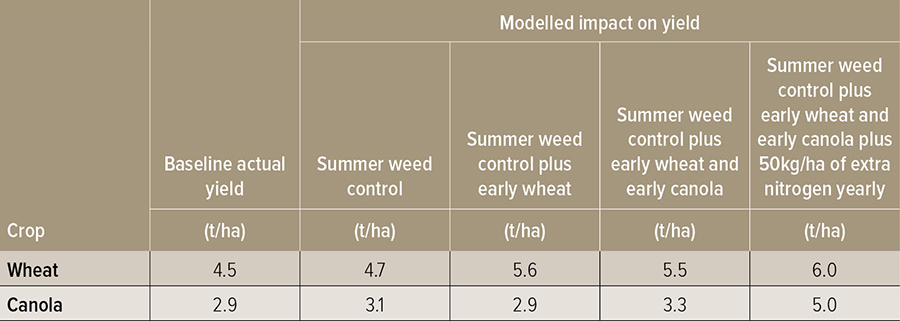
Source: Dr John Kirkegaard and Dr Julianne Lilley, CSIRO.
“At the time, dual-purpose crops were not front-of-mind for growers or scientists, but Dr Lilley showed that when there’s an opportunity to sow dual-purpose crops in March, you really can achieve a yield and grazing benefit that will add up to a significant whole-farm gain,” he says.
“Now, a lot of growers, including the O’Connor family, grow early sown grazing wheat and canola crops because it is profitable, but many growers were finding this out themselves, so our work and theirs occurred in parallel.”
Soil carbon
Other research that created plenty of interest among growers, consultants and scientists at Harden was initiated by CSIRO’s Dr Clive Kirkby to explore the fate of soil carbon under stubble retention and direct drilling compared to minimum tillage and burning.
Dr Kirby visited the site in 1996 while working as a CSIRO soil scientist in Adelaide and was disappointed to learn the direct-drilled and stubble-retained treatment had not sequestered more soil carbon.
“Clive couldn’t imagine why the soil carbon percentage was not higher under the direct-drilling and stubble-retention treatments,” Dr Kirkegaard says.
“He later moved to Griffith to work on a GRDC co-investment on stubble in irrigated farming systems and wondered if it was a lack of nutrients in the soil, not a lack of carbon, that limited organic matter build-up in the direct-drilled and stubble-retained treatments.”
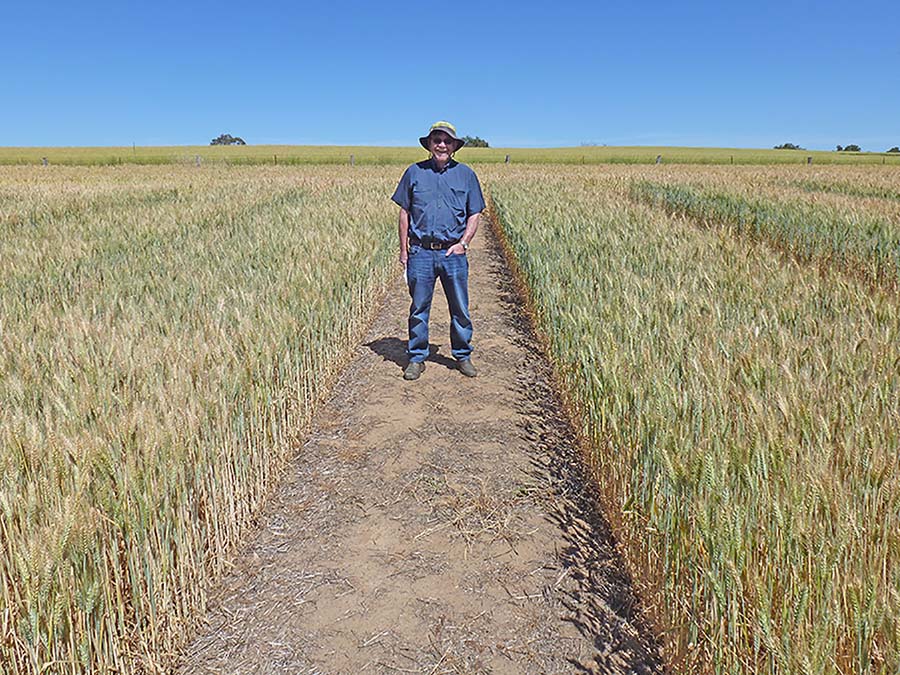
CSIRO’s Dr Clive Kirkby took soil samples to a depth of 1.8m to measure the change in soil carbon at the Harden long-term trial site. The results demonstrated seasonal conditions and nutrient ‘mining’ rather than tillage or stubble management had the biggest impact on soil carbon loss at the site. Photo: Dr John Kirkegaard, CSIRO.
Dr Kirkegaard says soil organic matter is more than carbon. The carbon percentage indicated in soil test results is a simple way to monitor organic matter.
“Clive’s theory was that plenty of carbon is returned to soil under stubble retention and direct drilling, but what needs to be created is organic matter, which comprises a mix of carbon, nitrogen, phosphorus and sulfur in relatively stable ratios,” he says.
“The stable ratios found in soil are similar to those found in bacteria and fungi because it is dead microorganisms, and not dead plant material, that are needed to make organic matter.
“Clive thought that perhaps crops had not been fertilised with sufficient nutrients to enable the microbes to convert the retained crop residues into organic matter.
“At the time, we expected soil organic matter to provide fertility but didn’t realise that to build soil organic matter we needed to add nutrients to feed the soil microorganisms.”
In 2007, GRDC provided co-investment for Dr Kirkby to complete his PhD and the long-term stubble-incorporated treatment at Harden was divided into two strips. Each year after harvest, he applied a small amount of starter fertiliser to one strip only before cultivating both strips with a rotary hoe. He repeated this for five consecutive years.
“After five years, the ‘no-nutrient’ side had lost 3.3 tonnes per hectare of carbon, while the ‘plus-nutrient’ side had gained 5.5t/ha of carbon,” Dr Kirkegaard says.
“The work explained the lack of carbon sequestered under the direct drilling and stubble retention despite the high levels of carbon added. We had been ‘mining’ nutrients in the system with associated loss of soil organic matter despite retaining about 20t/ha of above-ground carbon-rich residue over five growing seasons.”
Strategic tillage
By 2010, a common concern among long-term zero-tillage growers was that cultivation to incorporate lime or control weeds would damage the soil irreparably and any gains in soil carbon would be lost.
“But some tillage may be necessary to incorporate lime, manage Rhizoctonia, alleviate compaction, deal with slugs or rodents and assist with integrated weed management,” he says.
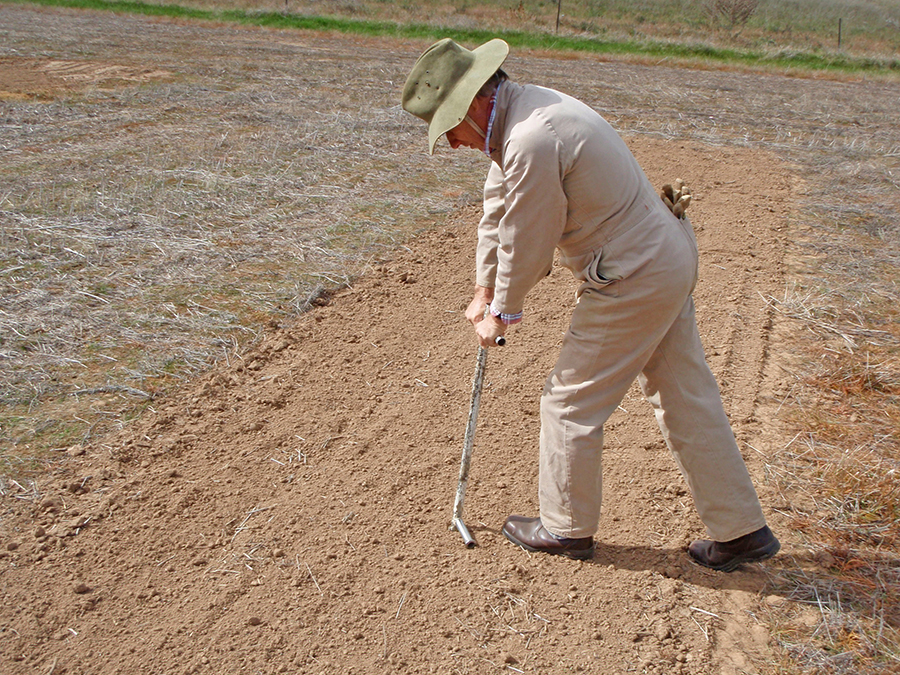
Dr Mark Conyers, formerly NSW Department of Primary Industries at Wagga Wagga, led a project with GRDC co-investment on strategic tillage in southern NSW. He used the CSIRO Harden long-term trial site between 2011 and 2015. The direct-drilled plots were cultivated once in 2011 and the soil and crops were then monitored for the next five years. Dr Conyers is pictured taking soil samples after the cultivation in 2011. The results showed few impacts of a single cultivation demonstrating that occasional ‘strategic tillage’ to incorporate lime or control weeds is unlikely to cause lasting damage to soil health. Photo: Dr John Kirkegaard, CSIRO
Working with then NSW DPI principal soil scientist Dr Mark Conyers, Dr Kirkegaard says the pair speculated that a one-off cultivation would do little lasting damage to the soil, but they had no specific data to reassure growers.
In response, Dr Conyers led a project with GRDC co-investment across four sites, including Harden, to explore the impact of a one-off tillage on soil condition and crop growth.
At Harden, Dr Conyers and Dr Kirkegaard divided the direct-drilled plots in half, both with and without stubble, and cultivated one half of each plot with a rotary hoe just once before sowing in 2011. They monitored the effects of this ‘strategic tillage’ for five years (see Table 2).
Table 2: A one-off strategic tillage in 2011 had little impact on crop yield1 over the following five years at the Harden long-term trial site.
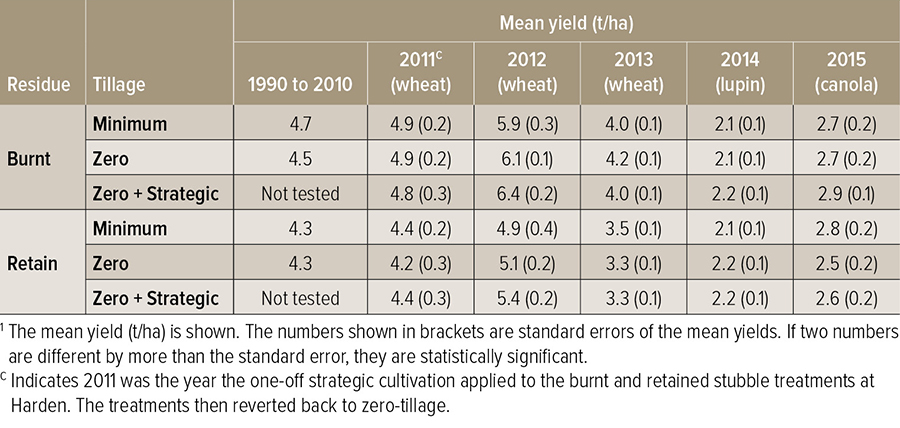
Source: Dr John Kirkegaard, CSIRO.
“There was a short-term effect on soil structure, which disappeared after one to two years,” Dr Kirkegaard says. “We didn’t lose a lot of soil carbon from that one-off cultivation and there were no negative impacts on crop growth or grain yield.”
He says the work demonstrated that growers can be confident the effect of occasional tillage on soil structure is temporary and may help reduce the concentration of carbon, phosphorus and pH that can become stratified into distinct layers in soil.
“Soil acidification in the subsurface (five to 15 centimetres) is a serious and widespread problem in the area that may be too costly to ameliorate unless it is addressed now,” he says. “Unfortunately, lime just doesn’t move very far if you don’t incorporate it”, so picking a safe time, usually coming out of pasture, makes sense.
Stubble and nitrogen
When Dr Kirkegaard and his colleagues looked at data from the Harden long-term trial site, they realised that stubble was having a bigger impact on yield than the tillage system used.
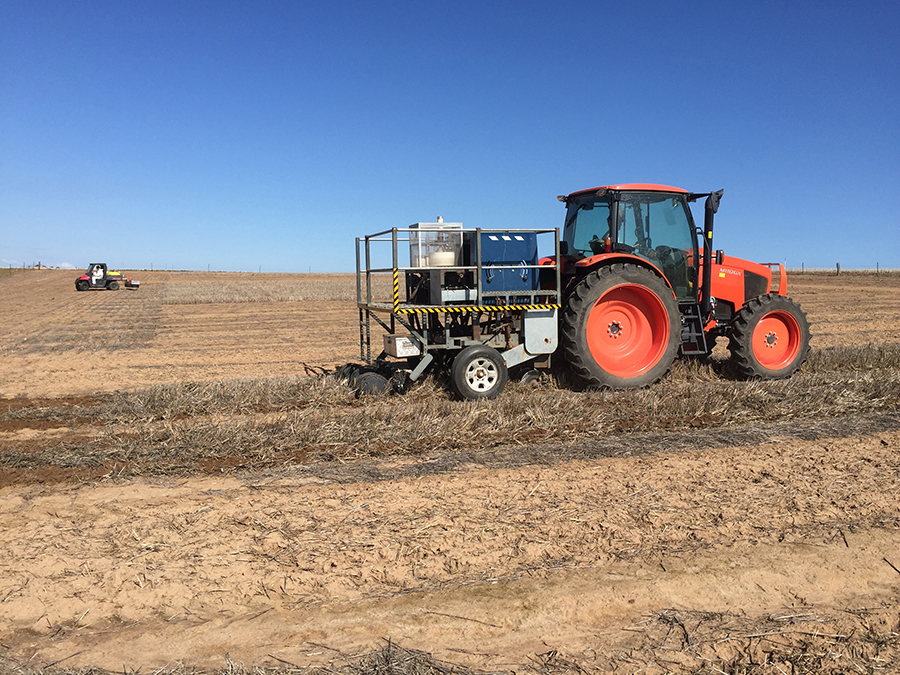
CSIRO seeding equipment used at the site evolved over the course of the experiment, from an International 911 drill in on 18cm rows in 1990, to a John Deere tyned seeder, and then to the latest seeder (pictured) with parallelogram tynes and press wheels. Photo: Tony Swan, CSIRO.
“On average, the long-term impact of tillage on wheat yield was plus or minus 0.1t/ha, whereas the impact of stubble was minus 0.3t/ha,” he says.
“Initially, we had ruled out nitrogen tie-up as the cause because pre-sowing mineral nitrogen levels did not differ between the treatments; however other work at Temora, NSW, suggested post-sowing tie-up was a likely mechanism reducing growth and yield in the stubble-retained direct-drilled systems.”
In 2017, as part of the GRDC Stubble Initiative, Dr Kirkegaard and Tony Swan added extra nitrogen at sowing to investigate how nitrogen tie-up affects wheat growth, yield and protein in stubble-retained and burnt treatments at Harden (see Table 3).
Table 3: The effects of added nitrogen on wheat growth, yield and protein in stubble-retained and burnt treatments at Harden in 2017.
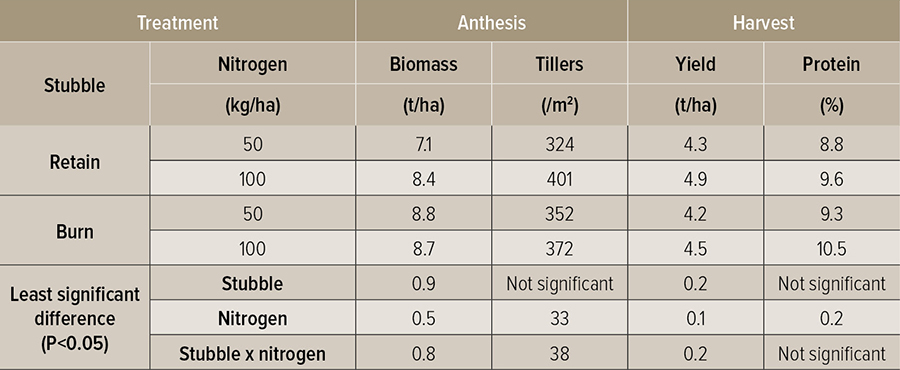
Source: Dr John Kirkegaard, CSIRO.
Stubble is a carbon-rich source of food for soil microbes. But soil microbes need carbon, nitrogen, phosphorus and sulfur sourced from the soil. In the short-term, this leads to nitrogen tie-up. But in the long-term, nitrogen returns to the soil and becomes plant-available when soil microbes die.
“Had we tested mineral nitrogen after sowing in winter, we would have discovered a difference between the stubble-retained and stubble-burned treatments as nitrogen tie-up is a process that continues through winter,” he says.
“There needs to be a supply of nutrients available early in the crop’s development to ensure microbes do not ‘steal’ nutrients from the crop.”
The work showed additional surface-applied nitrogen or nitrogen deep-banded at sowing could alleviate the early growth penalties in stubble-retained direct-drilled systems.
In the short-term, Dr Kirkegaard says, if microbes ‘steal’ nutrients from a crop early in its development, the setback can lead to a yield loss, often up to 0.5 t/ha.
“To improve early crop vigour, you only need five kilograms of extra nitrogen per tonne of wheat stubble, which can be spread on to the paddock before sowing,” he says. “If you are adding extra nitrogen at sowing, place it well away from the seed to prevent toxicity.”
Lesson learned
Dr Kirkegaard says an important lesson he learned from the Harden long-term trial site is that the run-down in soil carbon from long-term cropping is not driven by tillage, but by nutrient mining from the soil.

Pictured is the Harden trial site in March 2019 before sowing. Notice the bare soil treatment where rain has washed off the slope in the foreground compared with the stubble-retained treatments in the background. Photo: Nicole Baxter.
“When developing our crop nutrient budgets, we often assume 50kg of nitrogen is supplied from the soil, but what we have to remember is that this comes at a loss to soil organic matter measured as soil carbon,” he says.
“Looking back, I was probably too efficient when I was developing the fertiliser budgets for the treatments at the Harden long-term trial site and didn’t consider the nutrient needs of the soil microbes.
“Clive Kirkby was applying starter fertiliser and using a rotary hoe every year to mix wheat stubble through the soil and yet he still built 5.5t/ha of soil carbon over five years.
“Tillage isn’t the problem, but tillage without added nutrients will lead to significant loss of organic matter. We aren’t advocating the use of rotary hoes, but we now have a principle of nutrient balance to integrate into our zero-tillage systems if we want to maintain or sequester soil carbon.”
Next steps
Dr Kirkegaard says researchers and growers from the Harden Murrumburrah Landcare Group learned together at the Harden long-term trial site.
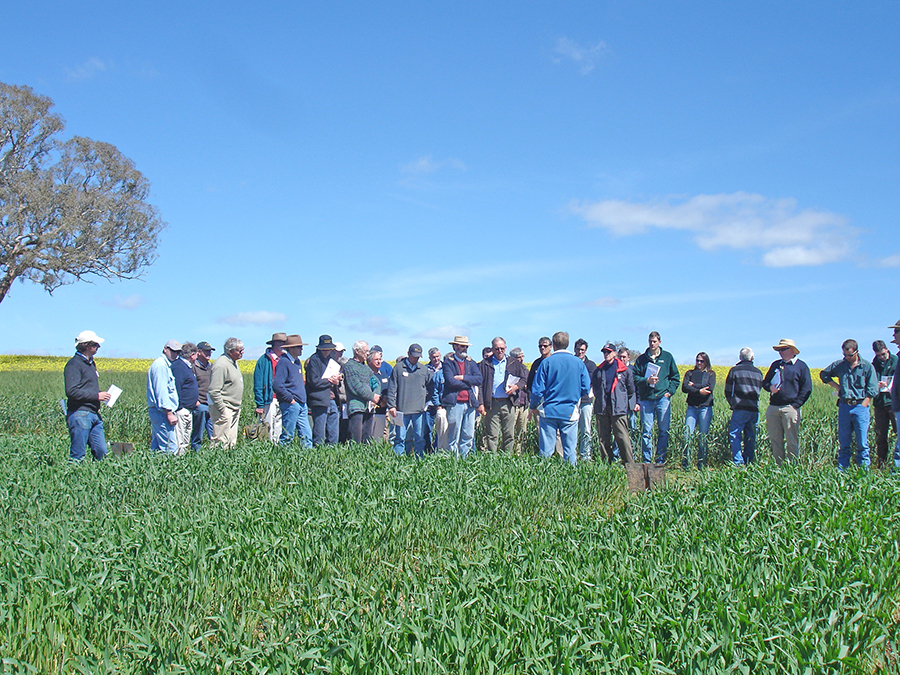
Local growers and members of the Harden Murrumburrah Landcare group join with the CSIRO scientists at the Harden long-term trial site in 2009 to celebrate 20 years of collaboration. Annual field days were well attended throughout the experiment’s long history as growers were keen to discuss new ideas to trial on their own farms. Photo: CSIRO.
“I am thankful to the PhD students, postdoctoral researchers, technicians, consultants, collaborators, colleagues and growers who have supported research at the site over 30 years,” he says. “And to CSIRO and GRDC for investment in our work.”
As the site is retired and the land returned to the O’Connor family later this year, Dr Kirkegaard is designing a new experiment that compares farming systems at CSIRO’s Boorowa Agricultural Research Station. He hopes it will build on the work at Harden.
Teamwork celebrated
Earlier this year, Dr Kirkegaard gathered with Harden Murrumburrah Landcare Group’s Louise Hufton and Oxton Park cropping manager Pat O’Connor. On the agenda for discussion was a small event to celebrate Oxton Park’s 100th year in farming and the 30-year partnership that developed between researchers, agronomists and growers at the Harden trial site.

At a meeting to organise a small gathering to celebrate 30 years of research at the Harden long-term site were Oxton Park’s Pat O'Connor, CSIRO’s Dr John Kirkegaard, Harden Murrumburrah Landcare Group’s Louise Hufton and CSIRO’s Jing Wang. Photo: Nicole Baxter.
When GroundCover™ visited the Harden site, it was fitting to see HyTTec® Trophy canola sown in late May, reflective of common cropping practice when the trial started in 1990.
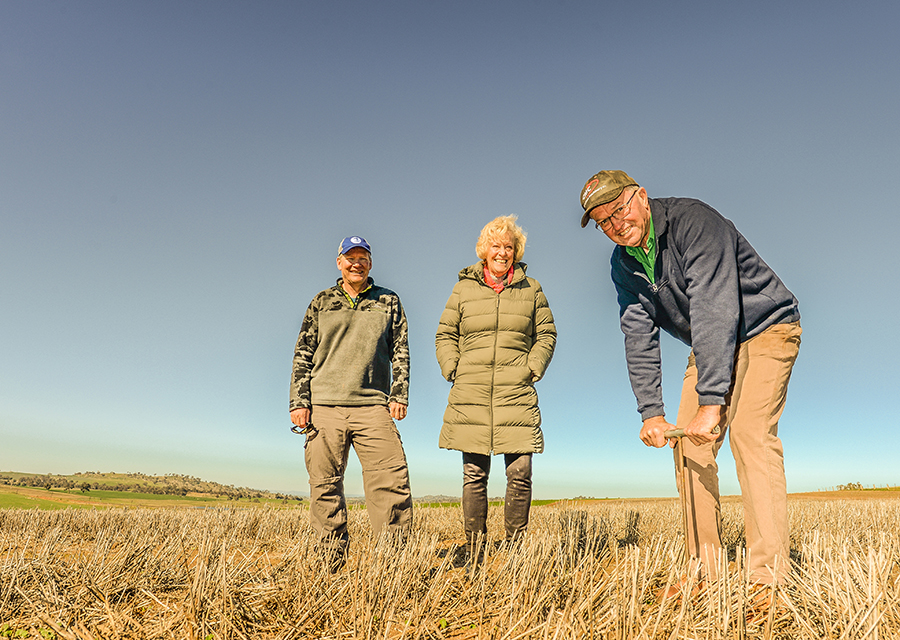
CSIRO’s Dr John Kirkegaard with Harden Murrumburrah Landcare Group’s Louise Hufton and Oxton Park’s Pat O’Connor checking soil moisture under late-May planted canola on the Harden long-term trial site. Photo: Nicole Baxter.
The crop’s slow development against the backdrop of the O’Connor family’s HyTTec® Trophy canola sown in late April is a stark reminder of just how significantly the thinking behind crop management has changed, in part because of the Harden research.
The advantage of the earlier-sown canola is noteworthy. It demonstrates that when grower observation and innovation is married with flexible and science-backed long-term trials and superior crop genetics, challenges can be overcome, cropping practices evolve and mixed-farming businesses with grain crops can not only persist, but adapt, strengthen and thrive.
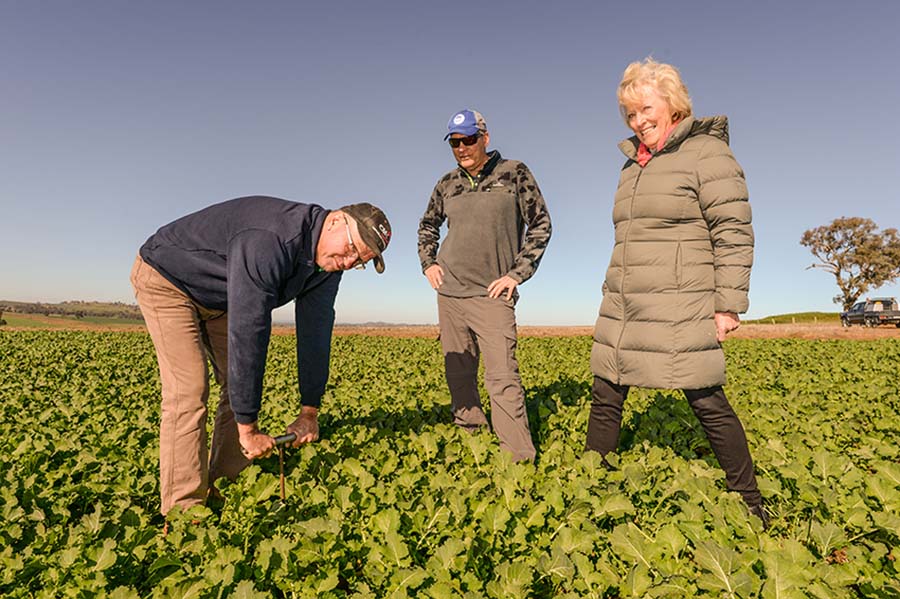
Oxton Park’s Pat O’Connor, CSIRO’s Dr John Kirkegaard and Harden Murrumburrah Landcare Group’s Louise Hufton in the O’Connor family’s late-April-planted canola that surrounds the Harden long-term trial site. Photo: Nicole Baxter.
GRDC Research Codes DAN316, CSP244, CSP244, CSO201, CSP329, CRF00002, DAN152, CSP00174, CSP00186
More information: John Kirkegaard, 0458 345 630, john.kirkegaard@csiro.au; Louise Hufton, 0499 166 279, huftonlouise@gmail.com; Pat O’Connor, 0407 267 213, pat@oxtonpark.com.au

























































